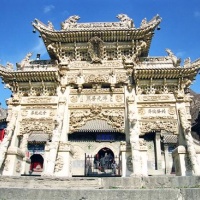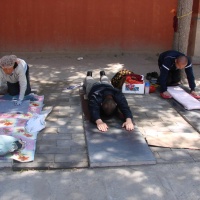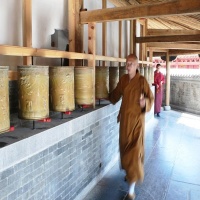- Home Page
- Fact Tours
Our sample tour itineraries of China and China travel packages are sorted by theme and available at competitive prices, you can browse what tours are right for you for your trip to China.
Popular China Tour Packages

Custom Tour Packages to China and Ask Our Experts for Free Enquiry !
- Coach Tours
- Destinations
Beijing, the capital of China. Its art treasures and universities have long made it a center of culture and art in China.
Beijing Top Attractions
Beijing City Tours
Best China Tours with Beijing
Shanghai, the cultural and economic center of East Asia. It renowned for its historical landmarks, the extensive and growing skyline.
Shanghai Top Attractions
Shanghai City Tours
Best China Tours with Shanghai
Xi'an, having held the position under several of the most important dynasties. It is the top destination to explore the facts of Chinese history.
Xi'an Top Attractions
Xi'an City Tours
Best China Tours with Xi'an
Huangshan boasts its culture, beautiful rivers, villages and mountains. It's home to 2 UNESCO World Heritage Sites and the Mecca of photographers.
Huangshan Top Attractions
Huangshan City Tours
Best China Tours with Huangshan
Sichuan is the cradle of the Shu culture, panda, mahjong, teahouse and spicy food. The province ranks first in China by number of UNESCO World Heritage Sites. It is called "the Heaven of Abundance".
Sichuan Top Attractions
Sichuan Tour Packages
Best China Tours with Sichuan
Yunnan, literally means the south of colorful clouds, due to its beautiful landscapes, mild climate and diverse ethnic cultures and traditions, is one of China's major tourist destinations.
Yunnan Top Attractions
Tibet, the nearest land to the sky, is known for its breathtaking landscape, splendid culture, art, buildings, and mysterious religions.
Tibet Top Attractions
Tibet Tour Packages
Best China Tours with Tibet
Explore the lost civilizations by riding a camel! Travel across the Gobi and the desert, and over the high mountains. Our Silk Road tours including different sections of the Silk Road in China.
Silk Road Top Attractions
Silk Road Tour Packages
Best China Tours with Silk Road
Guilin, an internationally-known historical and cultural city, has long been renowned for its unique karst scenery. Its vicinities are the paradise of hiking, caving, rafting, biking and countryside exploring.
Guilin Top Attractions
- China Facts
- China Hotels
- Travel Photos
Wutai Mountain
 With a perimeter of 250km, Wutai Mountain is one of the four famous Buddhist shrines in China. It enjoys the same popularity as Emei Mountain in Sichuan Province, and Putuo Mountain in Zhejiang Province, and Jiuhua Mountain in Anhui Province. The five plateform-shaped peaks, the East, West, South, North, and Central platforms formed Wutai Mountain. The area inside the five peaks is called Inner Wutai and outside Outer Wutai. At the East Platfrom (Sea-Viewing Peak0, the tourist can observe sunrise; at the West Platform (Hanging Moon Peak), the tourist can enjoy a bright full moon in mid-autumn whn the scenery is fascinating; at the South Platform (Brocade Peak), the tourist can mount the summit of the peak in summer and look around into the distance, where the scenery is enchanting; the elevation of the North Platform (Yedou Peak) is the highest - 3,058 meters, being the roof of North China, and is snow-and ice-capped all the year round, looking magnificent; at the Central Platform (Verdan Rock Peak), huge rocks covered by moss appear radiantly green under sunshine like seething dragons, hence the name "dragon-seething rocks." The area of Wutai Mountain features rising and falling ridges and peaks, crisscross gullies and ravines, river valleys, luxuriant forests and interlicking basins and mountians.
With a perimeter of 250km, Wutai Mountain is one of the four famous Buddhist shrines in China. It enjoys the same popularity as Emei Mountain in Sichuan Province, and Putuo Mountain in Zhejiang Province, and Jiuhua Mountain in Anhui Province. The five plateform-shaped peaks, the East, West, South, North, and Central platforms formed Wutai Mountain. The area inside the five peaks is called Inner Wutai and outside Outer Wutai. At the East Platfrom (Sea-Viewing Peak0, the tourist can observe sunrise; at the West Platform (Hanging Moon Peak), the tourist can enjoy a bright full moon in mid-autumn whn the scenery is fascinating; at the South Platform (Brocade Peak), the tourist can mount the summit of the peak in summer and look around into the distance, where the scenery is enchanting; the elevation of the North Platform (Yedou Peak) is the highest - 3,058 meters, being the roof of North China, and is snow-and ice-capped all the year round, looking magnificent; at the Central Platform (Verdan Rock Peak), huge rocks covered by moss appear radiantly green under sunshine like seething dragons, hence the name "dragon-seething rocks." The area of Wutai Mountain features rising and falling ridges and peaks, crisscross gullies and ravines, river valleys, luxuriant forests and interlicking basins and mountians.
Trip to this great UNESCO World Heritage Site, please join our perfect 7-Day Shanxi Tour
 More charming is the unique climate at Wutai Mountain. At the coldest spots ice dose not melt all the year round; at fairly cold places, it snows in September and thaws in April the following year; at fairly warmest places, rivers do not freeze and there is no frost the year round. At Wutai Mountain the difference in humidity is very great. As the climate here is cool even in mid-summer, Wutai Mountain is also known as Cool Mountain. The unique climate brings about unique scenery. Climbing up the summit of North Platform, the tourist sees peaks competing with one another for beauty among seething clouds. Sometimes, it rains heavily at the foot of the mountain, but the sun shines atop the summit; spring is very much in the air at the base, while the summit is covered with snow and ice. Climbing up the mountian on a fine day, the tourist will find a colorful semi-circular halo appearing by his side. The halo is about three meters high and about two meters wide, composed of red, orange, yellow, green, blue, and purple belts. One's shadow and movements will be reflected in halo (a bright circle of lights, as around the sun or moon in misty weather). It is the reflection at Wutai Mountain, the meteorological feature also known as the "Emai Halo."
More charming is the unique climate at Wutai Mountain. At the coldest spots ice dose not melt all the year round; at fairly cold places, it snows in September and thaws in April the following year; at fairly warmest places, rivers do not freeze and there is no frost the year round. At Wutai Mountain the difference in humidity is very great. As the climate here is cool even in mid-summer, Wutai Mountain is also known as Cool Mountain. The unique climate brings about unique scenery. Climbing up the summit of North Platform, the tourist sees peaks competing with one another for beauty among seething clouds. Sometimes, it rains heavily at the foot of the mountain, but the sun shines atop the summit; spring is very much in the air at the base, while the summit is covered with snow and ice. Climbing up the mountian on a fine day, the tourist will find a colorful semi-circular halo appearing by his side. The halo is about three meters high and about two meters wide, composed of red, orange, yellow, green, blue, and purple belts. One's shadow and movements will be reflected in halo (a bright circle of lights, as around the sun or moon in misty weather). It is the reflection at Wutai Mountain, the meteorological feature also known as the "Emai Halo."
Wutai Mountain, the Buddhist shrine, is said to be the place where Manjusri Buddha was consecrated. During the period 58 to 75, Emperor Ming Di (58-75) sent an envoy to go on a pilgrimage to India for Buddhist scriptures. After returning to the homeland, the envoy built the White Horse Temple at Luoyang and, in the following year, built a temple at Wutai Mountain. Legend has it that the peak to the west of the town of Taihuai resembled Divine Vulture Mountain in India, the newly built temple was named the Tafu Temple of the Divine Vulture, which is today the Temple of Revelation. In the following years, more and more temples were constructed at Wutai Mountain during the Northern Wei, Northern Qi, Sui, and Tang dynasties until the end of the Qing Dynasty.  According to historical records, there were more than 300 temples during the heyday of Wutai Mountain. However, due to social vicissitudes, the temples at Wutai Mountain experienced several rises and falls. Today, there are still 39 temples remainning in Inner Wutai and 8 temples in Outer Wutai, making a total of 47 temples. Among the temple at Wutai Mountain, Nanchan Temple, the Temple of Buddha's Halo, the Temple of Revelation, Dagoba Temple, Buddha Summit, Shuxiang Temple, Bishan Temple, Dragon Spring Temple, Nanshan Temple, Jinge Temple, Zhenhai Temple and Dailuo Summit are the most influntial ones. The above-mentioned temples are not only magnificent and exquisite in structure, but also preserve large quantities of valuable cultural relics and art works of Buddhism. The colored scultpture and mural of the Tang Dynasty, the white marble carvings of the Qing Dynasty, the Jade Buddha of Myanmar and Huayan Scripture Pagoda are all unique in China.
According to historical records, there were more than 300 temples during the heyday of Wutai Mountain. However, due to social vicissitudes, the temples at Wutai Mountain experienced several rises and falls. Today, there are still 39 temples remainning in Inner Wutai and 8 temples in Outer Wutai, making a total of 47 temples. Among the temple at Wutai Mountain, Nanchan Temple, the Temple of Buddha's Halo, the Temple of Revelation, Dagoba Temple, Buddha Summit, Shuxiang Temple, Bishan Temple, Dragon Spring Temple, Nanshan Temple, Jinge Temple, Zhenhai Temple and Dailuo Summit are the most influntial ones. The above-mentioned temples are not only magnificent and exquisite in structure, but also preserve large quantities of valuable cultural relics and art works of Buddhism. The colored scultpture and mural of the Tang Dynasty, the white marble carvings of the Qing Dynasty, the Jade Buddha of Myanmar and Huayan Scripture Pagoda are all unique in China.
Cool and tranquil, Wutai Mountain is a famous summer resort. To know you must go!
Questions & Comments
Home | About Us | Partnerships | Terms & Conditions | Privacy & Security | Payment Guide | Resource Links| Sitemap
Email: contact@chinafacttours.com, Tel: +86-773-3810160, Fax: (+86) 773-3810333
Copyright © 2008-2020 China Fact Tours. All rights reserved
![]()









